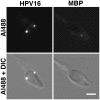Adsorption of human papillomavirus 16 to live human sperm
- PMID: 19513123
- PMCID: PMC2689348
- DOI: 10.1371/journal.pone.0005847
Adsorption of human papillomavirus 16 to live human sperm
Abstract
Human Papillomaviruses (HPVs) are a diverse group of viruses that infect the skin and mucosal tissues of humans. A high-risk subgroup of HPVs is associated with virtually all cases of cervical cancer [1]-[3]. High-risk HPVs are transmitted sexually; however, the exact mechanisms by which sexual contact promotes virus infection remain uncertain. To study this question we asked whether capsids of HPV type 16 (a high-risk HPV) specifically interact with sperm cells. We tested if purified HPV16 virions directly adsorb to live human sperm cells in native semen and in conditions that resemble the female genital tract. We found that HPV16 capsids bind efficiently to two distinct sites at the equatorial region of the sperm head surface. Moreover, we observed that the interaction of virus with sperm can be reduced by two HPV infection inhibitors, heparin and carrageenan. Our findings suggest that 1) sperm cells may serve as motile carriers that promote virus dispersal and mucosal penetration, and 2) blocking interactions between HPV16 and sperm cells may be an important strategy for the development of antiviral therapies.
Conflict of interest statement
Figures

Similar articles
-
Genital transmission of HPV in a mouse model is potentiated by nonoxynol-9 and inhibited by carrageenan.Nat Med. 2007 Jul;13(7):857-61. doi: 10.1038/nm1598. Epub 2007 Jul 1. Nat Med. 2007. PMID: 17603495
-
The presence of human papillomavirus in semen does not affect the integrity of sperm DNA.Andrologia. 2017 Dec;49(10). doi: 10.1111/and.12774. Epub 2017 Mar 6. Andrologia. 2017. PMID: 28261849
-
Mechanism of human papillomavirus binding to human spermatozoa and fertilizing ability of infected spermatozoa.PLoS One. 2011 Mar 7;6(3):e15036. doi: 10.1371/journal.pone.0015036. PLoS One. 2011. PMID: 21408100 Free PMC article.
-
The role of human papillomavirus on sperm function.Curr Opin Obstet Gynecol. 2011 Aug;23(4):232-7. doi: 10.1097/GCO.0b013e328348a3a4. Curr Opin Obstet Gynecol. 2011. PMID: 21666465 Review.
-
Biology and pathological associations of the human papillomaviruses: a review.Malays J Pathol. 1998 Jun;20(1):1-10. Malays J Pathol. 1998. PMID: 10879257 Review.
Cited by
-
Impact of high-risk and low-risk human papillomavirus infections on the male genital tract: effects on semen inflammation and sperm quality.Front Cell Infect Microbiol. 2024 Aug 23;14:1420307. doi: 10.3389/fcimb.2024.1420307. eCollection 2024. Front Cell Infect Microbiol. 2024. PMID: 39258253 Free PMC article.
-
Correlation between viral infections in male semen and infertility: a literature review.Virol J. 2024 Jul 30;21(1):167. doi: 10.1186/s12985-024-02431-w. Virol J. 2024. PMID: 39080728 Free PMC article. Review.
-
Screening for HPV-Related Oropharyngeal Cancer in Gay and Bisexual Men: Acceptability and Predicting Possible Use of "Oral Selfies" by Smartphone as a Secondary Prevention Approach.Venereology (Basel). 2023 Dec;2(4):180-193. doi: 10.3390/venereology2040016. Epub 2023 Dec 7. Venereology (Basel). 2023. PMID: 38515606 Free PMC article.
-
Human Papillomavirus and Male Infertility: What Do We Know?Int J Mol Sci. 2023 Dec 16;24(24):17562. doi: 10.3390/ijms242417562. Int J Mol Sci. 2023. PMID: 38139389 Free PMC article. Review.
-
Molecular study of the presence and transcriptional activity of HPV in semen.J Endocrinol Invest. 2024 Mar;47(3):557-570. doi: 10.1007/s40618-023-02167-4. Epub 2023 Aug 16. J Endocrinol Invest. 2024. PMID: 37584897 Free PMC article.
References
-
- Koutsky L. Epidemiology of genital human papillomavirus infection. Am J Med. 1997;102:3–8. - PubMed
-
- Stanley M, Pett M, Coleman N. HPV: from infection to cancer. Biochem Soc Trans. 2007;35:1456–1460. - PubMed
-
- zur Hausen H. Papillomaviruses causing cancer: evasion from host-cell control in early events in carcinogenesis. J Natl Cancer Inst. 2000;92:690–698. - PubMed
-
- Doorbar J. Molecular biology of human papillomavirus infection and cervical cancer. Clin Sci (Lond) 2006;110:525–541. - PubMed
Publication types
MeSH terms
Substances
Grants and funding
LinkOut - more resources
Full Text Sources

